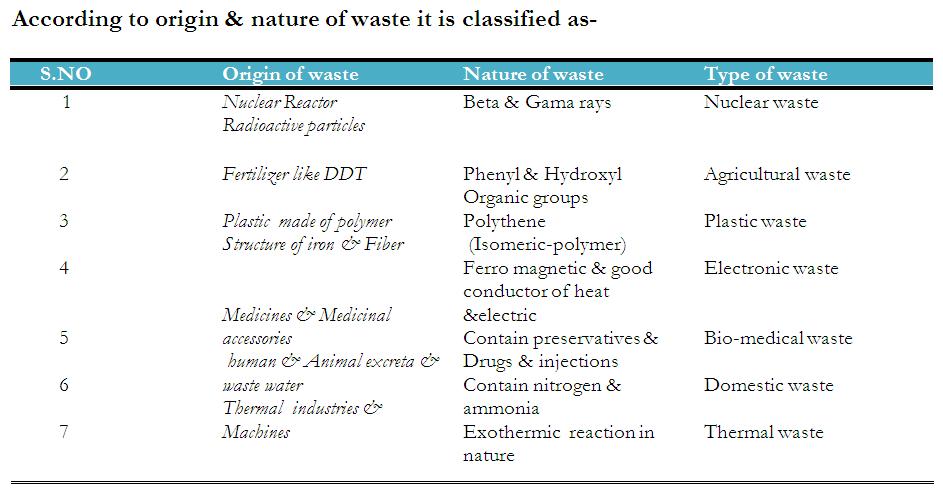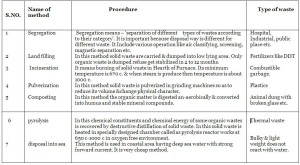Title: Solid Waste Management Technology
Author: Yogesh Tiwari, 2nd Year BE, Civil Engineering
Guide: Nitin Barsadge, Asst.Professor
College: GYAN SAGAR COLLEGE OF ENGINEERING
ABSTRACT: – Solid waste management is a boon for the human society. There is much need of solid waste management because today in 21St century we (human beings) are developing different Equipments & products to meet the demand of the human’s Ever. Thus it satisfied & developed the country in field of economy & increases its prosperity. But due to lack of awareness of people these products leads to form wastes. Now It’s our responsibility to aware society that (how to use & dispose the product) rather then It’s also a necessity of the government of particular area to develop different programs, schemes for the peoples so that people become aware of it. So government has formed an agency called as” Environmental Impact assessment (E.I.A)”
Thus according to the E.I.A, waste management is defined as “The application of the techniques that will ensure the orderly execution of the functions of Collection, Processing, Disposal of waste “. Therefore different methods of waste disposal are as Segregation, Land filling, Incineration, Pulverization, Composting etc. and all these methods give stress on 3 RS they are Reduce, Reuse, Recycle.
In this paper we are consulting on “Solid waste management & Its Impact on society”.
KEYWORDS: – Management, Environment, Techniques, E.I.A Reduce /Reuse /Recycle.
INTRODUCTION: – Solid waste management is a latest achievement which is able to control pollution produce by waste like plastic, fertilizers etc. thus solid waste management is a boon for the healthy environment and thus increases life sustainability. Solid waste management was started as there have been rise in the waste like agriculture, electronic, medical etc.
There is great impact of waste on human life & this affect is due to growth in:-Over population, Urbanization, Affluence, Technology
All These leads to the development of agency termed as “E.I.A”. The Phrase “Environmental Impact Assessment” comes from sec.102 (2) of the National Environmental policy Act (N.E.P.A) U.S.A. thus in European countries came into existence in 1987. Now the EIA become requirement in more than 100 countries. In India it came into existence around 1978-79 & made mandatory in 1994. Thus according to the E.I.A terms defined as-
What is solid waste?
Solid waste- All waste obtained in state of matter as (solid, semisolid, gas) is called as solid waste. It is arising from human and animal activities. It Include wastes such as garbage, residues, construction waste, dead animals, agricultural waste etc.
What is management?
Management – The process of proper arrangement and working procedure of any project with rules & regulations is termed as management.
What is solid waste management?
Solid waste management- The process of management of solid waste by following functions & methods according to the origin & nature of waste is called as solid waste management.
The detailed Description of 7 types of waste are–
1. Nuclear waste-
Nuclear waste refers to waste material that contains radioactive nuclei such as carbon-14, uranium-235 etc. the emission of energy from radioactive substances in environment is called as Radioactive or nuclear pollution.
Sources of waste-
1 Cosmic Rays from outer space.
2 Emissions from radioactive materials from Earth’s crust.
3 Use of radioactive material in nuclear power plant.
4 Use of Nuclear-weapons.
2. Agriculture waste- Modern agriculture practices have both positive & negative effects on Environment. Waste generated from such practice is agricultural waste.
Sources of waste-
1. Fertilizers
2. Pesticides
3. Insecticides
4. Sediments
3. Plastic waste-
Plastics are typically polymers of high molecular mass. They are of 2 types as Thermoplastics, thermo-set plastics. Waste from such polymers is plastic waste.
Sources of waste-
1. Polyethylene
2. Poly vinyl chloride
3. Poly styrene
4. Electronic waste-
Electronic waste is one of the most serious problems of 21st century. It cause due
To presence of lead, zinc etc.
Sources of waste-
1. Motherboards contain beryllium.
2. Batteries contain lead.
3. Circuit boards contain copper.
5. Bio-medical waste-
The waste generated from hospitals, nursing, Health centers etc. is called as bio-medical waste.
Sources of waste-
1. Syringes
2. Gloves
3. Blades
6. Domestic waste-
Domestic waste is those which obtained from household activities.
Sources of waste-
1. Garbage
2. Ashes
3. Sewage
7. Thermal waste –
Thermal waste refers the release of heat into any segments of environment.
Sources of waste-
1. Nuclear power plant
2. Coal fired power plant
3. Industrial effluent
4. Hydro electric power
Impact of waste on environment as-
1. Diseases like bacterial dysentery, diarrhea due to food & water contamination.
2. Rats depending on solid waste cause diseases like trichinosis plague due to direct bite.
3. Crops get contaminated led to cholera, jaundice.
4. Solid waste chokes the drain resulting diseases like malaria, dengue.
5. Cow & other animals consume polythene led them even to death.
Objectives of waste management-
The main objective of waste management include 3 basic functions as-
1. Collection
2. Processing
3. Disposal
These are described as-
1. Collection –
It is first fundamental function of waste management. It refers to the gathering of wastes from different places like residences, commercial, Institutional, public places etc.
It include 2 methods-
1. Hauled container system
2. Stationary container system
1. Hauled container system- In this container is hauled from collection point to final disposal point.
2. Stationary container system-In this container is emptied into collection vehicles at collection.
2. Processing-
It is second fundamental function of waste management. It refers to activity applied to Waste to prepare it for subsequent operation like recycling & recovery of materials.
3. Disposal-
It is 3rd fundamental function of waste management. Disposal refers to the placing of Waste in its ultimate resting place.
Methods of disposal of waste –
Importance of 3Rs in waste management –
1. Reduce-
Reduction in the raw materials is one of the fundamental ways to decrease the production of waste. This is achieved by using less raw- material when packing a product, designing of products etc.
2. Reuse –
Reuse of the materials in their original form is the next fundamental way to minimize the generation of wastes. Rather then it also saves money. Examples are-
• Reuse the refillable containers after washing.
• Wash & reuse disposable items like plastic bags etc.
3. Recycle-
Recycling is reprocessing of discarded materials that may have some economic value into new useful products. Examples are-
• Utilizing fly ash in brick making.
• Conversion of agriculture waste into cheap & efficient fuel.
Advantages of waste utilization-
• It contributes to economic development.
• Recycling helps in conversion of natural resources.
• Develop Eco-friendly environment.
• Employment opportunities are also generated.
Environment impact assessment cycle –
Environmental Impact assessment is a Eco-friendly assessment which follows about 15 steps in which the waste disposal from several projects have always been studied they are as –
• Project screening
• Scoping
• Description of project
• Description of environmental base line
• Identification of key impacts
• Prediction of impacts
• Evaluation of impacts
• Identification of mitigation measures
• Public consultancy
• Presentation of E.I.S.
• Review of E.I.S.
• Decision making
• Post decision monitoring
• Auditing
CONCLUSION- In this paper after technical study on solid waste management & Its Impact on society. I according to my vision conclude that though government is running several act like- “water protection act 1974”etc. but due lack of knowledge of people we destroy such a eco-friendly environment. Thus due to unawareness of people we (human-beings) have change climate, Increase our problems day by day. And the latest example In India I say is the Uttarakhand (Himachal) tsunami & as other country In America temperature decreases to (-55 c). & thus oceans & lakes freezes.
Thus it’s a necessity of every person to be aware of waste & Its Impact on Environment. If in future every person aware then we (human- beings) can say that ‘our Planet “EARTH” is safe’. And people & environment will together live as friend ever, since ancient times.
REFERENCES-
1. DR.SURINDER DESWAL – Energy, Environment, Ecology and Society, published by GAGAN KAPUR FOR DHANPAT RAI & CO. (P) LTD, EDITION: 2010.
2. E .P. ODUM- FUNDAMENTAL OF ECOLOGY PUBLISH BY TATA MAGRA HILL PVT LTD EDITION 2010.
3. Manual on sewage treatment (Ministry of urban development)
4. R. K. Trivedi- Handbook of environmental laws, rules, guidelines.


